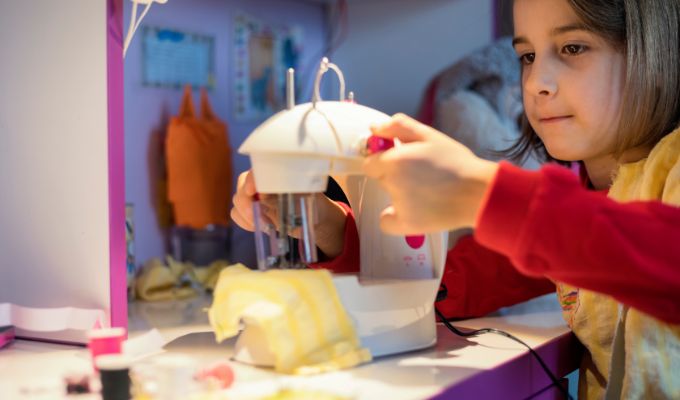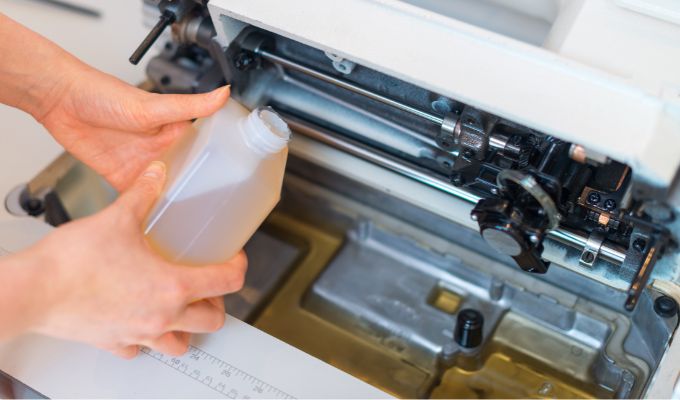Taking up sewing as a hobby is a great way to encourage kids to develop their confidence, self-reliance, and imagination. Though most sewing machines are straightforward to operate, there are heavy-duty and complicated computerised sewing machines that require some experience.
Thankfully, there is a range of excellent sewing machines that are designed specifically for kids that can help children learn at their own pace. We’ve shortlisted two top sewing machines from premium brands with great stitching performance that allows youngsters around 8 years and above to get into sewing, safely.
Singer 1306 Start Sewing Machine
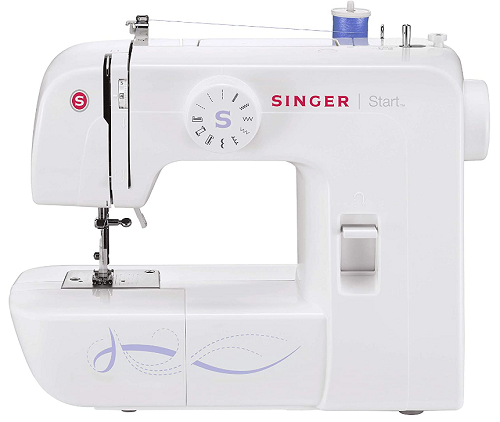
The Singer brand has been in the sewing machine market since 1851 and has built its reputation as one of the best sewing machine brands. They produce machines for all experience levels, from beginners to industry and commercial professionals.
This child-friendly sewing machine has the bare minimum – no complex bells and whistles, which is ideal for young aspiring sewists. It’s ideal for getting the feel for sewing, and understanding the mechanics, while providing great stitching results without any overwhelming features.
Siger 1306 Key Features
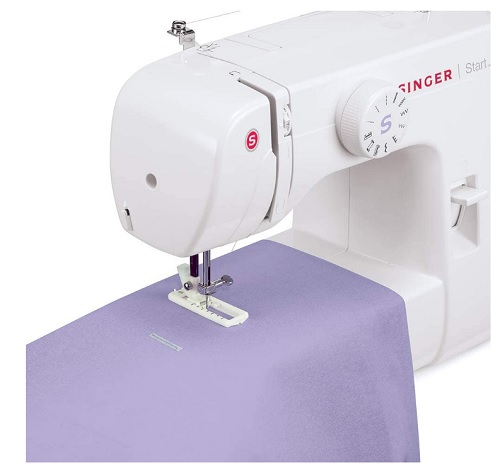
Size and weight: This machine is small and lightweight, making it simple to keep in a closet or transport wherever it is needed. It is 35 cm wide, 18 cm deep, and 29 cm tall. Because it only weighs 4.3 kilogrammes, it is also quite lightweight.
Stitches: It can stitch at a rate of 750 per minute. 3 straight stitches are available. You have three options: short, medium, and long. Additionally, there are 4 different zig-zag stitches available, giving you the option to select between a short and narrow, medium-medium, long and wide, or multiple zig-zag.
The machine gives you the option to create buttonholes; there are 4 processes involved. Finally, if you’d like, pick a point for ornamentation. Making your choice of point is simple and may be done with a wheel.
Threading: Again, there is no automatic threading, but we appreciate the instructions provided for the higher thread.
Spool holders: You can use a second spool holder to use the double needle.
Bobbin: Installing a bobbin is simple.
Its accessories include the regular presser foot, the buttonhole presser foot, and the zipper presser foot, as well as a seam ripper, a spool holder in two sizes, a needle case, a bobbin, a screwdriver, and a felt pad.
But aside from these add-ons, this basic machine is devoid of all of the extra features found on more expensive models, such as the thread cutter, the presser foot adjustment system, etc.
Who is the Singer Start 1306 for?
As we have seen, using this Singer 1306 sewing machine is a breeze and is perfect for you ages 8, 9, or 10 years.
As a newbie, your options may become quite constrained. Having a sewing machine that can grow with your needs is a nice perk of the starting models we’ve chosen. If, on the other hand, you only plan on sewing rarely, this is the machine for you.
You’ll be able to get the fundamentals done quickly and easily. hence it is also geared at younger people who want to learn how to sew. Finally, an experienced seamstress may find it helpful if she requires a second sewing machine that is lightweight and compact enough to bring along on trips.
Brother KE14s 14 “Little Angel” Stitch Sewing Machine
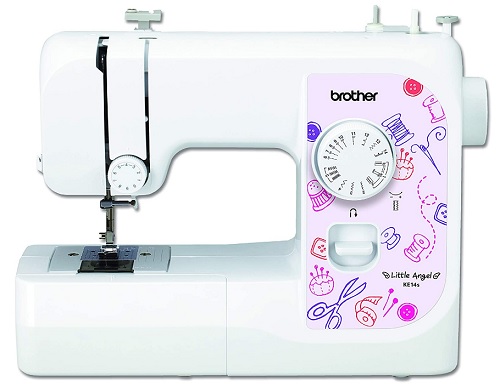
We love this model so much that it has become our go-to recommendation. Young novices will find the Brother KE14, a straightforward mechanical sewing machine, to be an ideal choice.
The machine has 14 built-in stitches, including the basics like a straight stitch, zigzag stitch, and buttonhole stitch as well as some more elaborate options. Use the shown instructions to thread the machine with ease.
In addition to the standard stitch length and width, this machine also includes an LED light, reverse, thread tension adjustment, and a finger guard. For the second time, Brother provides a high-quality sewing machine at an affordable price, making it possible for kids to learn the hobby without disrupting family life.
From what age can a child use a sewing machine?
This is a common concern when thinking about teaching a young child how to sew. If you start teaching your child to sew around the age of seven or eight, he or she will be able to use a genuine sewing machine.
At the very least, most brands have a child-friendly sewing machine in their product lines with simplified controls and preprogrammed stitches. An adult must always be present while a youngster uses his sewing machine, regardless of how safe the machine I
It might be too soon to give a child under the age of six access to a genuine sewing machine. Think more along the lines of “toy machines” that will let the little ones play without any danger to themselves.
A child of this age can also be gradually introduced to sewing through activities like handling fabrics and adjusting the settings on an adult’s sewing machine. If you are already proficient at sewing, this may be an excellent opportunity to further your skillset. They can get used to the controls and learn the proper motions before upgrading to their first “real” sewing machine.
Children as young as nine or ten can use adult sewing machines, and those with a real interest in the craft will find this to be the case regardless of age. The Brother CS10 and the Singer Initiale are both great options for adults looking for their first sewing machine. They can keep using the same machines for years to come to further their education.
Avoid “Toy” Type Sewing Machines
Believe it or not, this is crucial information. All the main toy retailers now stock kid-friendly sewing machines. As a result of their cheap construction and weak stitches, these machines are not suitable for heavy-duty work. Actually, a solid stitch requires both a top thread from the spool and a bottom thread from the bobbin.
A sewing machine with only one thread is more of a plaything than a useful tool. Young children who want to be like you may like using these “toy machines,” but older youngsters who are serious about learning to sew may be put off by them.
Criteria for Choosing a Child’s Sewing Machine
When shopping for a sewing machine for a kid, it’s important to prioritise simplicity and ease of use. Children are more likely to use a machine if it is intuitive for them to do so. Children are impatient and want to see the effects of their work as quickly and easily as possible, so too many options or settings might be frustrating for them.
It is important that the machine not overwhelm the child with an excessive number of stitches that he will never utilise. There need to be predetermined points so that the child isn’t constantly having to adjust the stitch length and/or width as they work.
The machine needs to be sturdy enough to resist the often erratic motions of kids, but lightweight enough to be conveniently carried from one place to another. Finally, a machine with a finger guard will keep your fingers away from the needle, ensuring the youngest sewn items are safe.
In conclusion, the following characteristics will define the adequate sewing machine for children:
- Machine should be robust, basic, and portable
- Sewing machine marketed towards younger users
- Avoid “toy” or “play” machines
- Wire threading made easier
- Sewing with two threads (bobbin and spool) ensures durability.
- Locked-in stitches
- A little over a dozen stitches
- Choose a reputable brand name
- Easy-to-use pedals for kids
- Controls for reversal and tension
Always supervise children using sewing machines. Only a competent adult with sewing experience should teach a child how to use a sewing machine safely and efficiently.
